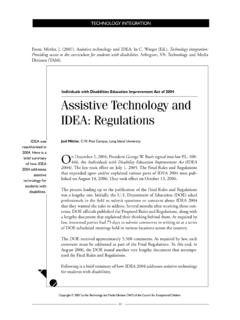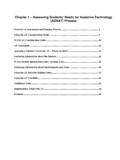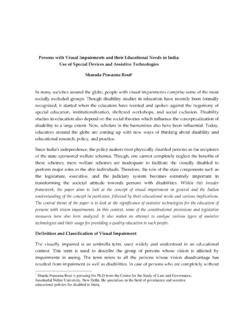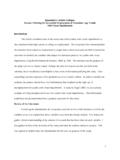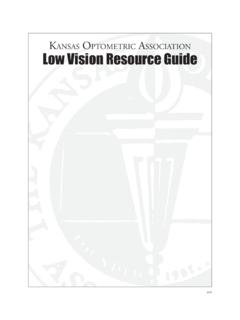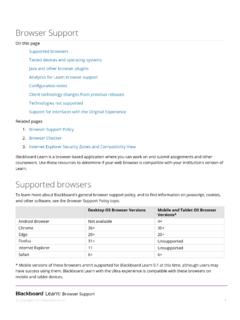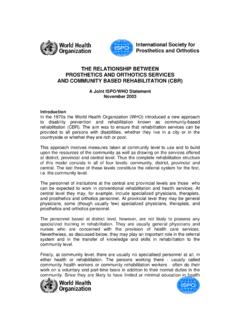Transcription of Learning Difficulties STUVWXYZ ABCDEFGHI …
1 ABCDEFGHIJKLMNOPQRSTUVWXYZABCDEFGHIJKLMN OPQRSTUVWXYZABCDEFGHIJKLMNOPQRSTUVWXYZAB CDEFGHIJKLMNOPA ssistive technology forChildren with Learning DifficultiesNew TechnologiesAdded!BridgesTo ReadingSECOND EDITIONNote To Our Readers:Educational and medical specialists use a variety of terms to refer tolearning problems, including Learning disabilities, Learning diffciulties, Learning disordersand Learning terms are used interchangeably throughout this guide. However, the term Learning disabilities is a professional and legal definition referring to disordersthat are believed to be due to central nervous system by The Frostig Center, assistive technology for Childrenwith Learning Difficultieswas underwritten by the Schwab Foundation for Learning , a nonprofit foundation dedicated to improving the lives of students with Learning this Guide was CompiledThis guide is based upon eight years of research conducted by theTrafford Center on technology and Learning Disabilities at the FrostigCenter in Pasadena.
2 California. Information has also been drawn fromthe authors previously published articles and research studies. Researchfunding has been provided by the Schwab Foundation for Learning , the Mufasa Trust and the Department of guide is part of Bridges To Reading,TMa comprehensive kit full of step-by-step strategies to identify, understand and address children sreading problems. If you wish to purchase a kit, or for more information,call 1-800-230-0988. EPrinted on recycled paper & 2000 Schwab Foundation for Learning1650 South Amphlett Blvd. #300, San Mateo, California 94402 All Rights technology for Childrenwith Learning DifficultiesThis guide was prepared by the Frostig Center in Pasadena, California,which is devoted to children with Learning disabilities.
3 Marshall Raskind, , Director of Research of the Center, was the project director and primary author. Dr. Raskind is an authority on technology and Learning author would like to thank Tobey Shaw, Dr. Nora Slaff, Dr. Eleanor Higgins, Dr. Bennett Ross and Dr. Roberta Goldberg for their assistance in the development of this 3 Bridges To ReadingAssistive technology for Children with Learning DifficultiesContentsWhat Is assistive technology ? ..4 Why Use assistive technology ? ..5 Types of assistive technology ..6 Written Language Technologies ..7 Reading Technologies.
4 10 Listening Technologies ..12 Organization/Memory Technologies ..13 Math Technologies ..13 Selecting the Best technology for Your Child ..14 Cost ..17 Closing Comments ..19 Steps to Success ..20 Frequently-Asked Questions ..21 Resources ..23 What Is assistive technology ?ssistive technology can be defined as any item, piece of equipment or system that helps people bypass, work aroundor compensate for Learning technology is an umbrella term, which can be divided into two main groups: hardwareand software. Hardwarerefers to actual equipment.
5 For example, tape recorders and calculators are two common types of hardware. On a computer, the hardware includes the central processing unit (the computer s box ), the monitor (the screen) and the internal circuit boards. Software,on the other hand, refers to the programs that run on computers, tellingthe computers what to purpose of assistive technology is to work around specificdeficits, rather than fixing them. It helps people with Learning differencesreach their full potential and live satisfying, rewarding lives. Assistivetechnology, however, should be a part of an overall program to help individuals with Learning differences.
6 Examples of assistive technology include hi-tech items, such asreading machines that read books out loud through a computerized voiceto help persons with reading difficulties. Speech recognition systems alsoPage 4 Bridges To ReadingAssistive technology for Children with Learning Difficulties Man is still themost extraordinarycomputer of all. John F. KennedyAbelong to the hi-tech group. These systems allow the user to write stories by talking to a computer, rather than having to write the wordsout by hand. Low-tech devices include more common, inexpensivetools.
7 For example, tape recorders enable individuals with memory or listening difficulties to permanently capture spoken information. Bothtypes of assistive technology make life easier for personswith Learning differences by allowing them to gatherinformation and express their own ideas using themethod that works best for people confuse assistive technology withinstructional software. As mentioned earlier, assistivetechnology is used to bypass, work aroundor compensatefor Learning difficulties. Instructional software, on the other hand, is designed to develop orimprove specific skills in such areas as reading, writing or math.
8 Assistivetechnology is not designed to improve particular skills or teach particularsubjects. Instead, it provides a means for the user to work around thelearning differences. This guide does not discuss instructional software,as that market is vast and ever-changing. The contents of this guide focuson the specific topic of assistive Use assistive technology ? Learning disabilities are professionally diagnosedlearning difficulties with reading, writing, speaking, listening, spelling, reasoning or math that are the result of a presumed central nervous system dysfunction.
9 Learning disabilities are neither cured nor with Learning differences grow up to be adults with learningdifferences. However, with hard work and helpful tools, children withlearning differences can greatly improve their success in these technology is one such 5 Bridges To ReadingAssistive technology for Children with Learning DifficultiesAssistive technologyhelps people workaround problems byfocusing on theirstrengths, rather thantheir 6 Bridges To ReadingAssistive technology for Children with Learning DifficultiesAlthough we tend to think of Learning differencesin terms of the school setting, individuals with Learning differences must also function at home.
10 Inthe workplace, at social gatherings and in recreationalactivities. Easily portable tools many of which arepocket-sized allow individuals to bring a bypassstrategy into many different settings. Now a person with a Learning difference can write a letter to a friend at home on a word processor. He can check for spelling errors at the library with an electronic spellchecker, or keep score in a card game at a friend s house with a technology provides support to get the job done. Finally, assistive technology helps increase the independence of persons with Learning differences.






